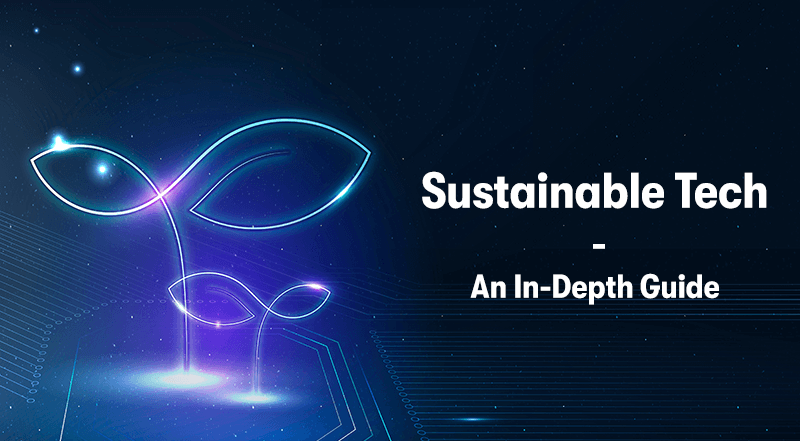Sustainable Tech - An In-Depth Guide
Welcome to our in-depth exploration of sustainable technology, a field rapidly reshaping how we interact with our environment and conduct business in the 21st century. At its core, sustainable technology represents an innovative fusion of environmental consciousness with cutting-edge technological advancements. It's a driving force behind numerous industries' efforts to minimise their ecological footprint while maximising efficiency and productivity. This concept is not just a trend but a necessary evolution, addressing the pressing need to balance economic growth with environmental stewardship.
In this blog, we'll uncover the various facets of sustainable technology, from its fundamental principles to its impactful applications across different sectors, illustrating its critical role in steering us towards a more sustainable and prosperous future.
What is Sustainable Tech?
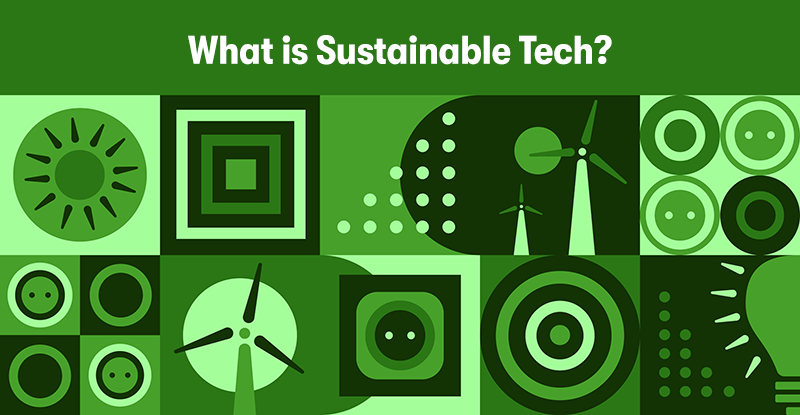
Sustainable technology, often referred to as sustainable tech, encompasses a broad range of innovations and practices designed to reduce negative environmental impacts, promote efficient use of resources, and support ecological balance. The key principles of sustainable technology include:
Environmental Friendliness
Technologies that minimise pollution reduce carbon footprint and are less environmentally harmful. This includes clean energy sources like solar, wind, and hydroelectric power.
Resource Efficiency
Maximising the efficiency of resource use, which includes using renewable resources wherever possible and minimising waste. For example, technologies that support recycling and upcycling fall into this category.
Sustainability in Design and Manufacturing
The development of products and infrastructure in a way that considers their environmental impact over their entire lifecycle, from production to disposal. This might involve using sustainable materials, designing for longevity and reparability, and ensuring energy-efficient operation.
Economic Viability
While environmental considerations are paramount, sustainable technology must also be economically feasible. It should offer a competitive alternative to non-sustainable technologies in terms of cost and performance.
Social Responsibility
Ensuring technology development, deployment, and disposal do not negatively impact communities. This can include considerations like fair labour practices, community involvement, and ensuring access to technology across different societal groups.
Examples of sustainable technologies include electric vehicles, energy-efficient appliances, green building materials, and smart grid technology. The goal is to create a more sustainable future by reducing dependence on non-renewable resources, decreasing pollution and greenhouse gas emissions, and fostering a healthier environment.
Why is Sustainable Technology Important for Business?
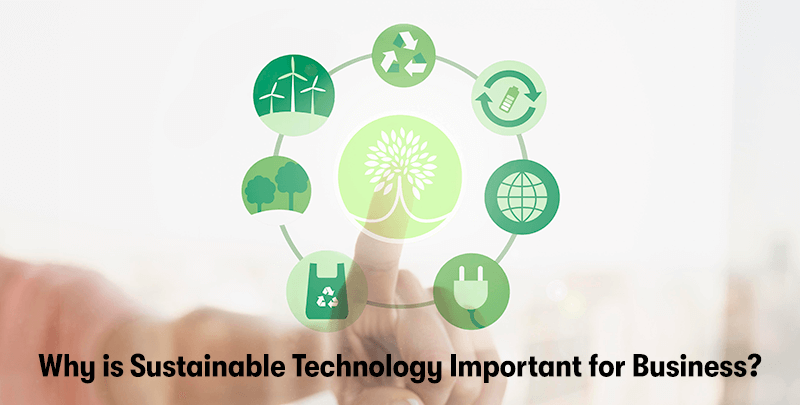
Sustainable technology is crucial for businesses for several reasons, encompassing not only environmental benefits but also economic and social advantages:
Cost Reduction
Sustainable technologies often lead to significant savings in the long run. Energy-efficient systems and renewable energy sources can reduce utility costs. Sustainable practices like recycling and waste reduction can also lower operational expenses.
Compliance and Risk Management
As governments worldwide impose stricter environmental regulations, adopting sustainable technologies helps businesses stay compliant and avoid legal penalties. It also reduces the risk associated with reliance on finite resources and the vulnerabilities of environmental impacts.
Market Demand and Competitive Advantage
Consumers are increasingly environmentally conscious, often preferring to support businesses that demonstrate a commitment to sustainability. By integrating sustainable technology, businesses can meet this market demand, enhancing their brand image and gaining a competitive edge.
Investment and Funding Opportunities
There's a growing trend of investors favouring environmentally responsible companies. Sustainable technology adoption can make businesses more attractive to these investors, opening up opportunities for funding and partnerships.
Innovation and Long-term Viability
The shift towards sustainable technology often drives innovation, leading to new products, services, and business models. This not only contributes to the long-term viability of the business but can also create opportunities for leadership in emerging markets.
Employee Morale and Attraction
Companies known for their sustainability efforts tend to attract talent who value corporate responsibility, leading to a motivated and committed workforce.
Supply Chain Sustainability
Implementing sustainable technologies can lead to more efficient and resilient supply chains. This is increasingly important as customers and regulatory bodies demand greater transparency and responsibility in supply chains.
Corporate Social Responsibility (CSR)
Sustainable technology is a key component of CSR. It demonstrates a commitment to social and environmental responsibilities, which can enhance reputation and stakeholder trust.
Future-proofing the Business
By adopting sustainable technologies, businesses prepare for a future where resources might be scarcer, and environmental regulations are likely to be even more stringent.
Global Impact and Leadership
Companies that embrace sustainable technology contribute to global efforts against environmental challenges like climate change. This can position them as leaders in corporate responsibility, setting an example for others in their industry.
In summary, sustainable technology is not just an environmental imperative for businesses; it's a strategic necessity that drives innovation, competitiveness, and resilience in a rapidly evolving global market.
Good Examples of Sustainability in Technology
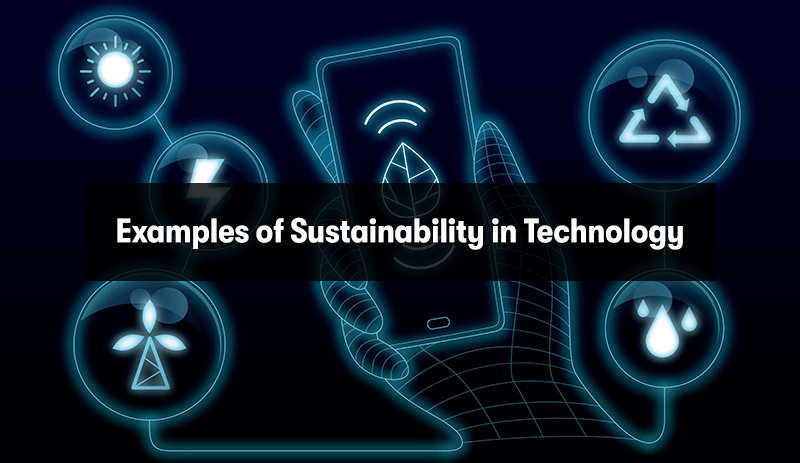
There are several notable examples of sustainability in technology that span various industries and applications:
Renewable Energy Sources
Technologies like solar panels, wind turbines, and hydroelectric power plants are quintessential examples. They provide clean, renewable sources of energy, reducing dependence on fossil fuels and lowering greenhouse gas emissions.
Electric and Hybrid Vehicles
These vehicles, powered by electricity (either fully or partially), are essential in reducing emissions from the transportation sector. They are becoming more accessible and efficient, with advancements in battery technology and charging infrastructure.
Energy-efficient Appliances and Buildings
Technologies that reduce energy consumption in homes and commercial buildings, like LED lighting, energy-efficient heating and cooling systems, and smart thermostats, contribute significantly to sustainability.
Smart Grid Technology
Modernising the electricity grid with smart technology helps efficiently manage and distribute renewable energy sources, reduce energy waste, and improve the reliability and sustainability of power systems.
Water Conservation Technologies
Innovations like low-flow faucets, efficient irrigation systems, and water recycling methods help conserve water, an increasingly scarce resource.
Sustainable Materials
Developing biodegradable, recyclable, or compostable materials, especially as alternatives to plastics and other non-degradable materials, is a significant step towards sustainability in manufacturing and product design.
Green Building Practices
Sustainable construction technologies, including green roofing, energy-efficient windows, and eco-friendly building materials, contribute to the creation of buildings with a lower environmental footprint.
Waste-to-Energy Technologies
These technologies involve converting waste materials into usable forms of energy, like electricity, heat, or fuel. It's an innovative way of managing waste while generating energy.
Precision Agriculture
Using technology like satellite imagery, drones, and IoT sensors for efficient farming helps reduce waste, conserve resources, and minimise chemical usage while maximising crop yields.
Carbon Capture and Storage (CCS)
Technologies that capture carbon dioxide emissions from sources like power plants and industrial processes and store them underground to prevent them from entering the atmosphere are critical in the fight against climate change.
These examples represent the diverse ways in which technology is being leveraged to create a more sustainable and environmentally friendly future. Each technology contributes to reducing our ecological footprint and moving towards a more sustainable way of living and doing business.
What Role Can Tech Play in Sustainability?
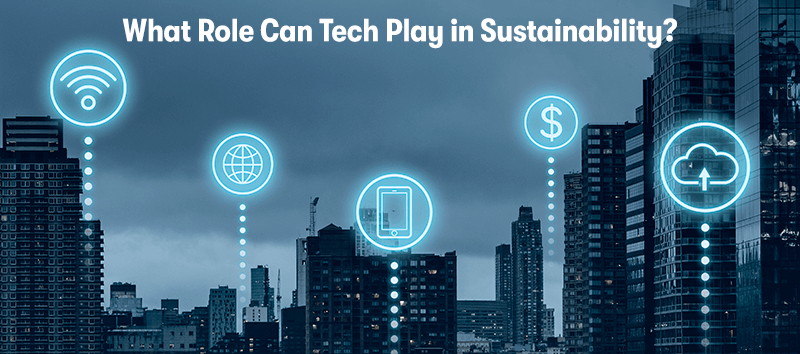
Technology plays a multifaceted and critical role in advancing sustainability in various sectors. Here's an overview of how technology contributes to sustainability:
Efficiency Enhancement
Technology can significantly increase efficiency in resource use. For instance, smart energy systems optimise electricity use, while advanced manufacturing technologies minimise material waste.
Renewable Energy Development
Technological advancements in solar, wind, hydroelectric, and geothermal energy have made renewable sources more viable and cost-effective, reducing reliance on fossil fuels and decreasing greenhouse gas emissions.
Sustainable Transportation
Electric vehicles (EVs), along with improved public transportation systems powered by clean energy, are vital in reducing the transportation sector's carbon footprint.
Data Analytics and Monitoring
Big data and analytics play a crucial role in sustainability. They provide insights for better decision-making in areas like resource management, energy use, and supply chain efficiency.
Agricultural Innovation
Technologies like precision agriculture, which uses drones, IoT devices, and AI, help in efficient farming practices, reducing water, fertiliser, and pesticide use while maximising crop yields.
Waste Reduction and Recycling
Tech-driven recycling processes and innovative waste management solutions, such as AI-powered sorting systems, contribute to more effective recycling and waste reduction.
Carbon Capture and Storage
Advanced technologies are being developed to capture and store carbon emissions from industrial processes, helping to mitigate the impact of these emissions on climate change.
Smart Cities
Integrating technology into urban planning leads to smarter, more sustainable cities. This includes everything from energy-efficient buildings to smart public transportation networks.
Water Conservation
Technology aids in water conservation through efficient water management systems, leak detection technologies, and water purification and recycling methods.
Consumer Behaviour Influence
Apps and platforms can encourage sustainable consumer behaviours by providing information on products' environmental impact, promoting sharing economy models, and facilitating the adoption of sustainable practices.
Corporate Sustainability Reporting
Technology enables better sustainability reporting and transparency for businesses, helping stakeholders understand and assess a company's environmental impact.
Research and Development
Tech accelerates research into new materials and processes that are more sustainable, such as biodegradable plastics or energy-efficient production techniques.
Environmental Monitoring and Protection
Technology plays a vital role in environmental conservation efforts, from satellite imaging for deforestation monitoring to drones for wildlife protection.
In summary, technology is integral to sustainability efforts across all sectors. It not only helps reduce the environmental footprint of human activities but also drives sustainable economic growth and social development.
How Can You Use Sustainable Tech in Your Business?
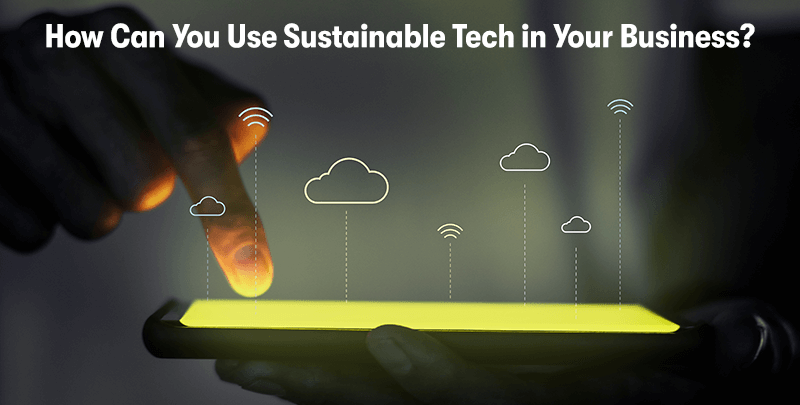
Integrating sustainable technology into your business can be approached in various ways, depending on your industry, scale, and specific operations. Here are some strategies to consider:
Energy Efficiency
Start by reducing energy consumption with LED lighting, energy-efficient appliances, and smart thermostats. If feasible, consider investing in renewable energy sources like solar panels or wind turbines.
Sustainable Office Practices
Implement paperless workflows using digital tools. Use recycled materials for office supplies and opt for eco-friendly office furniture.
Green Computing
Invest in energy-efficient computers and servers. Encourage practices like shutting down computers when not in use and using cloud computing services, which can be more energy-efficient than traditional on-premises data centres.
Eco-friendly Product Design and Packaging
Design products with sustainability in mind – use recyclable or biodegradable materials and minimise packaging. For existing products, assess if there are ways to make them more sustainable.
Waste Reduction and Recycling
Implement comprehensive recycling programs in your office. Explore opportunities for reducing waste in your production processes and consider ways to repurpose waste materials.
Sustainable Supply Chain Management
Opt for suppliers who practice sustainability and use technology to optimise supply chain logistics for efficiency and reduced carbon footprint.
Smart Building Technology
If you own your business premises, consider investing in smart building technologies that manage energy use more efficiently, like automated HVAC systems and motion sensors for lighting.
Remote Work and Teleconferencing
Encourage remote work when possible to reduce commuting emissions. Use teleconferencing tools to minimise business travel.
Fleet Management
Consider transitioning to electric or hybrid vehicles if your business relies on vehicle transportation. Use fleet management software to optimise routes and reduce fuel consumption.
Employee Engagement and Training
Educate your employees about sustainability practices and encourage them to contribute ideas for making the workplace more eco-friendly.
Monitoring and Reporting Tools
Use software tools to track your business's energy consumption, carbon footprint, and overall environmental impact. Regular reporting can help identify areas for improvement.
Investing in R&D for Sustainability
Allocate resources towards research and development focused on sustainability in your products or processes.
Partnerships for Sustainability
Collaborate with other businesses or organisations on sustainability projects. This can include joint ventures in renewable energy projects or community sustainability initiatives.
Sustainability as a Business Model
Consider how sustainability can be integrated into the core of your business model, not just as an add-on. This could mean offering products or services that directly contribute to environmental sustainability.
Remember, the key to successfully implementing sustainable technology in your business is to start with a clear strategy, engage stakeholders at all levels, and continuously monitor and adjust your approach based on performance and feedback.
What is Digital Sustainability?
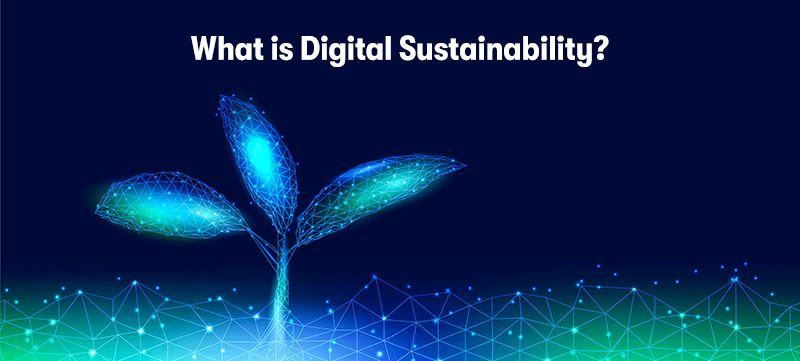
Digital sustainability refers to the practice of designing, implementing, and using digital technologies in a way that supports long-term ecological balance and reduces negative impacts on the environment. This concept is becoming increasingly important as our reliance on digital technologies grows, and it encompasses several key aspects:
Energy Efficiency of Digital Systems
This involves making more energy-efficient digital infrastructures like data centres, networks, and devices. Since these systems consume a significant amount of electricity, optimising their energy usage is crucial for reducing greenhouse gas emissions, especially if the energy is sourced from fossil fuels.
Sustainable Design and Production
It includes creating digital devices and components (like smartphones, computers, and servers) with sustainability in mind. This could mean using recyclable or biodegradable materials, designing for longevity and reparability, and reducing the use of toxic substances in manufacturing.
Responsible E-Waste Management
Proper disposal and recycling of electronic waste are vital components of digital sustainability. E-waste is one of the fastest-growing waste streams, and it often contains hazardous materials that can harm the environment and human health if not handled properly.
Reducing Digital Footprint
This aspect involves minimising the environmental impact of digital activities. For example, optimising data usage and storage, reducing the frequency of device upgrades, and choosing cloud providers who use renewable energy sources.
Sustainable Software Development
Developing software in a way that requires less computational power and, consequently, less energy. This includes writing efficient code, choosing appropriate algorithms, and considering energy consumption in the software design process.
Dematerialisation
Replacing physical products and services with digital alternatives (like e-books, online streaming, and virtual meetings) can reduce material and energy consumption. However, it's important to balance this with the energy demands of digital services.
Green IT Policies
Implementing organisational policies that prioritise sustainability in the IT sector. This could involve setting targets for reducing the carbon footprint of IT operations, procuring sustainable IT products, and promoting eco-friendly practices among employees.
Awareness and Education
Raising awareness about the environmental impacts of digital technologies and educating users on how to use these technologies responsibly.
Digital sustainability is an evolving field, reflecting the ongoing challenge of balancing the benefits of digital transformation with the need to protect our environment. As technology continues to advance, the pursuit of digital sustainability will likely become an integral part of both corporate strategies and public policies.
Where Can You Learn More About Digital Sustainability?
At Purple Griffon, we offer an ITIL® 4 Specialist Sustainability in Digital & IT (SDIT) training course. This course will help you to:
- Understand how to use the ITIL guiding principles to deliver value by creating sustainable digitally enabled products and services.
- Effectively address VUCA challenges through sustainable strategies, procurement, products and practices.
- Obtain a practical grounding in the key principles of sustainability.
- Conduct a complete cost-benefit analysis identifying potential risks and opportunities using best practice guidance.
Final Notes on Technology and Sustainability
In conclusion, our exploration of sustainable technology has highlighted its multifaceted role in shaping a more environmentally friendly and resource-efficient future. From the basics of sustainable tech to its vital importance in the business sector, we've delved into how it's transforming industries and driving innovation. We've seen excellent examples of sustainable technologies in action, underscoring their potential in various fields.
Furthermore, we've discussed practical ways businesses can integrate sustainable tech, emphasising its strategic necessity. Lastly, we touched on the emerging concept of digital sustainability, showcasing its significance in our increasingly digital world. As we continue to navigate environmental sustainability challenges, the integration and advancement of sustainable technology remain key to achieving a balanced and eco-friendly future.
Stay tuned for more insights and discussions on similar transformative topics.


